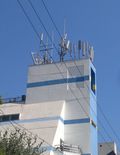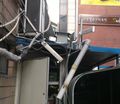 After my somewhat down to earth mobile network experiences in Beijing I've traveled on to Seoul, Korea and here, network connectivity was just the opposite. Internet hotel access was fast, 3G mobile networks were everywhere, voice quality in calls to Europe was superb and my email and web browsing via the UMTS was again as it should be: Yes, fast. Just around the corner from the hotel were small shops and restaurants that seemed very popular with the local youth. People are stylish and everyone seemed to carry at least two Samsung smartphones with at least one in active use at any time. Many people in restaurants were students working with books and their notebooks, connected to the Internet of course. I've seen a lot when it comes to mobile network usage but this is a new dimension. So obviously I wondered how mobile network operators cover this area!?
After my somewhat down to earth mobile network experiences in Beijing I've traveled on to Seoul, Korea and here, network connectivity was just the opposite. Internet hotel access was fast, 3G mobile networks were everywhere, voice quality in calls to Europe was superb and my email and web browsing via the UMTS was again as it should be: Yes, fast. Just around the corner from the hotel were small shops and restaurants that seemed very popular with the local youth. People are stylish and everyone seemed to carry at least two Samsung smartphones with at least one in active use at any time. Many people in restaurants were students working with books and their notebooks, connected to the Internet of course. I've seen a lot when it comes to mobile network usage but this is a new dimension. So obviously I wondered how mobile network operators cover this area!?
 I'd say government employees in French libraries complaining about headaches after Wi-Fi access points for visitors were installed would drop dead instantly from self inflicted fear in this area. It seems that everything that does not move has several antennas on top or on the side. Cables from telephone poles outside seemed to spread out in a big web to the houses nearby in total chaos, Wi-Fi access points are mounted to poles and even to cable loops themselves (picture one on the left). Antennas on seemingly every second rooftop pointed in all directions (second picture on the left) and were almost as plentiful as the Wi-Fi access points at street level.
I'd say government employees in French libraries complaining about headaches after Wi-Fi access points for visitors were installed would drop dead instantly from self inflicted fear in this area. It seems that everything that does not move has several antennas on top or on the side. Cables from telephone poles outside seemed to spread out in a big web to the houses nearby in total chaos, Wi-Fi access points are mounted to poles and even to cable loops themselves (picture one on the left). Antennas on seemingly every second rooftop pointed in all directions (second picture on the left) and were almost as plentiful as the Wi-Fi access points at street level.
And then there were those strange antennas at street level everywhere that seemed to be pointed in random directions down alleys, at buildings and many of them seemed to be, well, not quite pointed into the direction anymore as originally intended. The third picture shows a not out of the ordinary example.
I tried to figure out what exactly those antennas are for. Some of them say "KT Wibro" on the side which is descriptive enough but none of those I had a closer look at with my mobile tracer seemed to emit a 3G signal. After I saw those antennas again in other less frequented parts of the city in even more impossible locations I am pretty much convinced they connect to home Wi-Fi routers or are at the other end of indoor repeaters.
tried to figure out what exactly those antennas are for. Some of them say "KT Wibro" on the side which is descriptive enough but none of those I had a closer look at with my mobile tracer seemed to emit a 3G signal. After I saw those antennas again in other less frequented parts of the city in even more impossible locations I am pretty much convinced they connect to home Wi-Fi routers or are at the other end of indoor repeaters.
Despite the wired and wireless chaos, it seems to work as my calls got thorough, my Internet worked and probably also for the people glued to the screens of their smartphones in the streets. Stay tuned, in the next post I'll get somewhat more technical with an insight on on cell density, interference and signal strengths in this area.
coverage is amazing there. I remember taking the stairs in the hotel and a cable running down the stair well to provide indoor coverage.
and in the underground malls
and in the metro
and in the …
WiBro is Korea WiMAX I believe and why your 3G would not pick up. Not sure if WiBro ever went anywhere big time. maybe they converted the WiMAX antennae to WiFi?
have fun there. great city
Hi Martin,
just 2 comments on your great article.
You wrote: “everything that does not move has several antennas on top or on the side.” Even the moving things have several antennas.
I was surprised to get Wi-Fi on public city buses too!
KT Wibro (WIMAX) is still alive and it’s working well, giving a superb high speed connectivity. I am frequently using a Wibro / Wi-fi converter when I’m in Korea.
Enjoy Korea!
Vincent
Hi Martin
I agree coverage in Seuol is very good.
They use a lot of repeaters in Korea. It easily outnumbers the number base stations. I have heard numbers 5-10 times as many repeaters as base stations.
Cheers
Johan